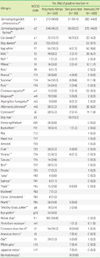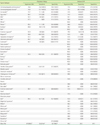Abstract
Background
Multiple Antigen Simultaneous Test (MAST)-immunoblot assay is a practical and economical test, which has been recently introduced nationwide. Authors investigated test efficiency of a MAST-immunoblot assay, Polycheck Allergy (PA).
Methods
A total of 3,153 patients were tested by PA and the results were compared with the results of ImmunoCAP and skin prick test (SPT) in 532 and 75 patients, respectively. The correlation with the lgE results measured by VIDAS was also analyzed.
Results
The agreements of PA with SPT were 87.8% in the Inhalant Panel and 89.3% in the Food Panel and the agreement of ImmunoCAP with SPT was 95.2%. The most common allergens giving positive reactions were Dermatophagoides farinae (46.2%) and Dermatophagoides pteronyssinus (40.0%). SPT taken as a reference, PA compared with ImmunoCAP showed higher agreement (D. farinae, 76.0 vs. 70.7%; D. pteronyssinus, 76.0 vs. 74.4%), sensitivity (D. farinae, 72.7 vs. 68.2%; D. pteronyssinus, 75.0 vs. 71.2%) and specificity (D. farinae, 85.0 vs. 81.3%) except for the specificity for D. pteronyssinus (78.3 vs. 87.5%). The rate of allergen specific IgE positive patients was higher than that of negative patients when total IgE was over 100 kU/L.
Conclusions
Our results showed that the agreement, sensitivity and specificity of PA were similar to or better than those of the previously established test, ImmunoCAP. The allergen specific IgE results of PA were in correlation with total IgE. PA may be used for testing allergen specific IgE to diagnose and treat allergic diseases.
Figures and Tables
Fig. 1
Polycheck Allergy results plotted against ImmunoCAP results. Correlation coefficients (r2) between ImmunoCAP and Polycheck Allergy for Dermatophagoides farina and Dermatophagoides pteronyssinus were 0.46 and 0.43, respectively (each, P<0.001).

Fig. 2
Number of allergen-specific IgE detected simultaneously by Polycheck Allergy. The number of most frequently detected allergen-specific IgE was 3 (23.3%, 124/532) in inhalant panel and 1 (14.1%, 75/532) in food panel.

Table 1
Age and sex distribution of patients tested with Polycheck Allergy, ImmunoCAP, and skin prick test

Table 2
Positive rate of each allergen-specific IgE detected by Polycheck Allergy, skin prick test, and ImmunoCAP

References
1. Min YG, Jung HW, Kim HS, Park SK, Yoo KY. Prevalence and risk factors for perennial allergic rhinitis in Korea: results of a nationwide survey. Clin Otolaryngol Allied Sci. 1997. 22:139–144.

2. Lee SI, Shin MH, Lee HB, Lee JS, Son BK, Koh YY, et al. Prevalences of symptoms of asthma and other allergic diseases in korean children: a nationwide questionnaire survey. J Korean Med Sci. 2001. 16:155–164.

3. Suh M, Kim HH, Sohn MH, Kim KE, Kim C, Shin DC. Prevalence of allergic diseases among Korean school-age children: a nationwide cross-sectional questionnaire study. J Korean Med Sci. 2011. 26:332–338.

4. Douglass JA, O'Hehir RE. 1. Diagnosis, treatment and prevention of allergic disease: the basics. Med J Aust. 2006. 185:228–233.

5. Nelson HS. Diagnostic procedures in allergy. I. Allergy skin testing. Ann Allergy. 1983. 51:411–418.
7. Pipkorn U. Pharmacological influence of antiallergic medication on in vivo allergen testing. Allergy. 1988. 43:81–86.

9. Wide L, Bennich H, Johansson SG. Diagnosis of allergy by an in-vitro test for allergen antibodies. Lancet. 1967. 2:1105–1107.

10. Lim HS, Kim HS, Oh H. Current status of serum allergen tests in Korea. Korean J Lab Med. 2008. 28:124–129.

11. Brown CR, Higgins KW, Frazer K, Schoelz LK, Dyminski JW, Marinkovich VA, et al. Simultaneous determination of total IgE and allergen-specific IgE in serum by the MAST chemiluminescent assay system. Clin Chem. 1985. 31:1500–1505.

12. Lim HS, Yoon JK, Lee HH. Allergen patterns using MAST CLA test in Korean pediatric patients. Korean J Clin Pathol. 2001. 21:292–297.
13. Yang SE, Oh HB, Hong SJ, Moon DH, Chi HS. Analysis of MAST chemiluminescent assay (MAST CLA) results performed in Asan Medical Center: Suggestion for the improvement of MAST CLA performance. Korean J Clin Pathol. 1998. 18:660–666.
14. Dreborg S. The skin prick test in the diagnosis of atopic allergy. J Am Acad Dermatol. 1989. 21:820–821.

15. Mosbech H, Nielsen NH, Dirksen A, Launbjerg J, Biering I, Søborg M. Comparison between specific IgE measured by RAST, two chemiluminescent assays and skin prick test. Allergol Immunopathol (Madr). 1992. 20:220–224.
16. Eiken P, Mosbech H, Jacobsen L, Larsen P, Scharling B, Svendsen UG, et al. Comparison between two different assays for measurements of allergen-specific IgE and skin prick test in the diagnosis of insect venom allergy. Allergy. 1992. 47:495–497.

17. Scolozzi R, Boccafogli A, Vicentini L, Baraldi A, Bagni B. Correlation of MAST chemiluminescent assay (CLA) with RAST and skin prick tests for diagnosis of inhalant allergic disease. Ann Allergy. 1989. 62:193a–193b.
18. Lee S, Lim HS, Park J, Kim HS. A new automated multiple allergen simultaneous test-chemiluminescent assay (MAST-CLA) using an AP720S analyzer. Clin Chim Acta. 2009. 402:182–188.

19. Jang WR, Nahm CH, Kim JH, Lim DH, Jang TY, Moon YS, et al. Allergen specific IgE measurement with Polycheck Allergy: comparison of three multiple allergen simultaneous tests. Korean J Lab Med. 2009. 29:465–472.

20. Contin-Bordes C, Petersen A, Chahine I, Boralevi F, Chahine H, Taïeb A, et al. Comparison of ADVIA Centaur and Pharmacia UniCAP tests in the diagnosis of food allergy in children with atopic dermatitis. Pediatr Allergy Immunol. 2007. 18:614–620.

21. Cha YJ, Chae SL, Park AJ. Evaluation of the MAST CLA assay system for measuring total IgE: Comparison with the pharmacia CAP system. Korean J Clin Pathol. 1999. 19:342–347.
22. Nepper-Christensen S, Backer V, DuBuske LM, Nolte H. In vitro diagnostic evaluation of patients with inhalant allergies: summary of probability outcomes comparing results of CLA- and CAP-specific immunoglobulin E test systems. Allergy Asthma Proc. 2003. 24:253–258.
23. Kim HS, Kim DJ, Lee SG. Analysis of simultaneous positivity to multiple allergens on MAST CLA Test. Korean J Lab Med. 2005. 25:448–456.
24. Agha F, Sadaruddin A, Abbas S, Ali SM. Serum IgE levels in patients with allergic problems and healthy subjects. J Pak Med Assoc. 1997. 47:166–169.
25. Backer V, Ulrik CS, Wendelboe D, Bach-Mortensen N, Hansen KK, Laursen EM, et al. Distribution of serum IgE in children and adolescents aged 7 to 16 years in Copenhagen, in relation to factors of importance. Allergy. 1992. 47:484–489.





 PDF
PDF ePub
ePub Citation
Citation Print
Print






 XML Download
XML Download